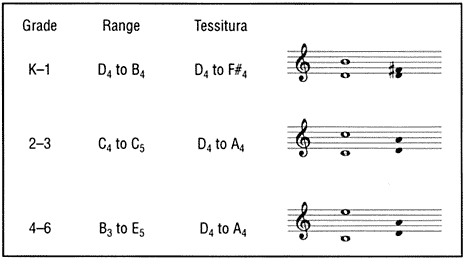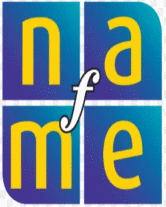Numerous criteria need to be considered when deciding uponthe appropriateness of a song for use with students. The following suggestions should all be considered.
Range and Tessitura:
Range refers to the lowest and highest notes employed by asong. Tessitura refers to the range where the majority of thenotes lie. These should correspond to the range of the studentsin a particular class. However, a general guideline is providedbelow.

Vocal Demands:
Several vocal demands should be considered when determining the appropriateness of a song for young singers.
- Look at the treatment of the register lift in the song. The liftoccurs between the pitches A4 and B4-flat or B4. It is mucheasier for students to shift registers by jumping over the liftand then descending diatonically through it than to ascenddiatonically through it.
- Contrary to popular notion, it is actually easier for students tosing skips, especially descending skips, rather than singingscaler patterns.
- Consider the tempo of songs as well as rhythm pattern difficulty. Young students should not have to sing at a fast tempoand should not have to move the voice rapidly with difficultrhythm patterns.
- Several notes sung on one syllable melismas presentproblems for most elementary school students, as does onenote repeated several times. Those vocal demands that pose aproblem for young students also seem to pose a problem foradolescent singers.
Usually, songs intended for K-2 are too long. This does not seemto be a problem with songs published for older students. Generally,songs of four phrases of four beats are appropriate for primarygrades, songs of eight four-beat phrases for middle grades, withlonger songs being appropriate but not necessary, for upper elementary grades. However, adolescent singers should not sing extremelylong songs or for long periods of time.
Repetition:
Most songs have repetition of some sort, such as tonal patterns,rhythm patterns, or text. More repetition is needed for younger students than for older students. The easiest type of repetition is whenthe words, melody, and rhythm repeat. A melody that repeats withdifferent words is a bit more difficult but does not usually cause anyproblems for the students. However, when words repeat on a differentmelody, the students seem to have some difficulty, especially in K-2.Try to avoid this type of repetition for younger singers, and do notbecome frustrated if they have difficulty with this.
Meter:
Students need to sing songs in a variety of meters. Therefore,guard against singing only duple songs. If you have difficulty inlocating triple meter songs, find a new duple song and teach it as atriple song. However, do not present a "common" song in a meterother than that in which it is traditionally sung.
Mode:
As with meter, students need to sing songs in a variety of modes.Since major songs seem to be in abundance, be on the lookout forminor songs as well as those in more unusual modes. You may alsopresent a major song in minor (similar to the meter switch). Again,do not make this switch with a "common" song.
Text:
While the text of a song is certainly an important consideration, itshould not be the only or most important criterion. It is important toknow your students and then select a text based upon their experiences and one that seems relevant to their lives. Also, do not ignoreforeign language texts; secondary school students especially likethese. Finally, be certain that the text and music match.
Call-and-response songs work very well with students. Look forsongs that have a repeated section that is easy for the students tosing in response to the teacher singing the other sections.
Finally, choose song materials carefully. Remember to make adistinction between songs for listening and songs for singing inmusic class for vocal development. Many songs that are popularwith students, often those from various television shows, do notencourage singing accuracy because the range is generally too wideand the text too complicated for the students to think about actuallysinging correctly. These songs may be fine for listening to at home,but they are not appropriate to sing in music class if the goal isvocal development.











